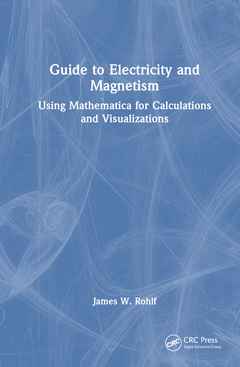Description
Guide to Electricity and Magnetism
Using Mathematica for Calculations and Visualizations
Author: Rohlf James W.
Language: English
Subjects for Guide to Electricity and Magnetism:
Publication date: 03-2024
· 15.6x23.4 cm · Hardback
Publication date: 03-2024
· 15.6x23.4 cm · Paperback
Description
/li>Contents
/li>Readership
/li>Biography
/li>
This is a ?how to guide? for a calculus-based introductory course in electricity and magnetism. Students taking the subject at an intermediate or advanced level may also find it to be a useful reference. The calculations are performed in Mathematica, and stress graphical visualization, units, and numerical answers. The techniques show the student how to learn the physics without being hung up on the math. There is a continuing movement to introduce more advanced computational methods into lower-level physics courses. Mathematica is a unique tool in that code is written as "human readable" much like one writes a traditional equation on the board.
Key Features:
- Concise summary of the physics concepts.
- Over 300 worked examples in Mathematica.
- Tutorial to allow a beginner to produce fast results.
The companion code for this book can be found here: https://physics.bu.edu/~rohlf/code.html
Chapter 1: Coulomb's Law and Electric Field. Chapter 2: Gauss's Law. Chapter 3: Electric Potenial. Chapter 4: The Biot-Savart Law. Chapter 5: Ampere's Law. Chapter 6: Magnetic Vector Potential. Chapter 7: Faraday's Law. Chapter 8: Circuits. Chapter 9: Fields Inside Materials. Chapter 10: Electromagnetic Waves. Chapter 11: Fields in Moving Frames of Reference. Appendix A: Mathematica Starter. Appendix B: Vectors. Appendix C: Spherical and Cylindrical Coordinates. Index
James Rohlf is a Professor at Boston University. As a graduate student he worked on the first experiment to trigger on hadron jets with a calorimeter, Fermilab E260. His thesis (G. C. Fox, advisor, C. Barnes, R. P. Feynman, R. Gomez) used the model of Field and Feynman to compare observed jets from hadron collisions to that from electron-positron collisions and made detailed acceptance corrections to arrive at first the measurement of quark-quark scattering cross sections. His thesis is published in Nuclear Physics B171 (1980) 1. At the Cornell Electron Storage Rings, he worked on the discovery of the Upsilon (4S) resonance and using novel event shape variables developed by Steven Wolfram and his thesis advisor, Geoffrey Fox. He performed particle identification of kaons and charmed mesons to establish the quark decay sequence, b –> c. At CERN, he worked on the discovery of the W and Z bosons and measurement of their properties. Presently, he is working on the Compact Muon Solenoid (CMS) experiment at the CERN Large Hadron Collider (LHC) which discovered the Higgs boson and is searching for new phenomena beyond the standard model.

